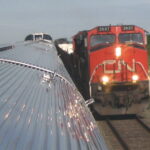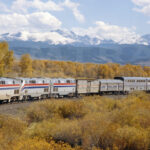Coast to Coast Across Canada by Rail … Part Five
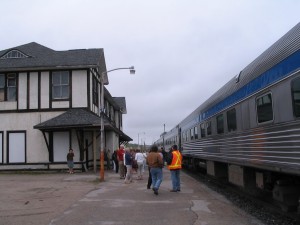 Evidently freight traffic delays us during the night because we’re behind schedule by almost two hours when we arrive at Sioux Lookout late the next morning. The population here is just 3000, but it’s the largest community we’ve seen since leaving Sudbury, 1200 kilometers behind us.
Evidently freight traffic delays us during the night because we’re behind schedule by almost two hours when we arrive at Sioux Lookout late the next morning. The population here is just 3000, but it’s the largest community we’ve seen since leaving Sudbury, 1200 kilometers behind us.
Throughout the afternoon, the Canadian rocks along at a steady 70 mph across Canada’s vast breadbasket – endless fields of grain, much of which is shipped back east over these same tracks to Quebec, where it’s loaded on ships for Eastern Europe.
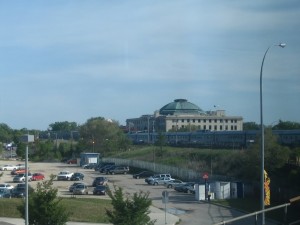 The city of Winnipeg comes in the early evening (that’s their wonderful train station up ahead in the photo above) and brings a new complement of car attendants to look after us from here to Vancouver. The dining cars also have new staffs – two cooks, a steward and three servers in each. Because the train is running late, the Toronto crews handled the first two dinner sittings, then seamlessly turned things over to their replacements for the third. Our new steward says cheerfully, “You got to be flexible to work for a railroad.”
The city of Winnipeg comes in the early evening (that’s their wonderful train station up ahead in the photo above) and brings a new complement of car attendants to look after us from here to Vancouver. The dining cars also have new staffs – two cooks, a steward and three servers in each. Because the train is running late, the Toronto crews handled the first two dinner sittings, then seamlessly turned things over to their replacements for the third. Our new steward says cheerfully, “You got to be flexible to work for a railroad.”
My choices for dinner include onion soup followed by pork roast garnished with a glazed onion sauce and a sprig of fresh rosemary. Desert is a delicate apple torte. A very acceptable Canadian sauvignon blanc accompanies the meal and the glorious sunset occurring across the vista ahead – orange giving ‘way to pink, all streaked with wisps of purple.
VIA Rail’s official timetable lists 67 stops for Train # 1, but only eleven are regular ones. The rest are “flag stops” where the train stops only if someone is getting on or off and only on 48 hours notice. One of these is Brandon North, 140 miles or so west of Winnipeg. There’s a station here, but the building is so small it could easily be hauled away on a flatbed truck. The Canadian stops just long enough for a young man in a military uniform to board, leaving a middle-aged couple behind on the platform. The woman dabs at her eyes with a paisley handkerchief; the man’s expression is grim.
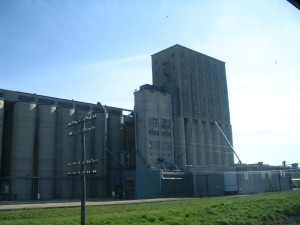 Morning finds the Canadian still on the prairie – wheat and horses and cattle and the huge grain elevators, but an occasional oil well has been added to the passing scene.
Morning finds the Canadian still on the prairie – wheat and horses and cattle and the huge grain elevators, but an occasional oil well has been added to the passing scene.
There’s more wildlife today: deer and antelope, bald eagles, wild geese and even sea gulls, congregating in what appears to be a low spot in the prairie filled with rainwater. We trundle onto a trestle crossing a picturesque little valley. A stream winds away to the south with three beaver dams and lodges clearly visible. Every so often we pass small ranch houses, most with trees planted on several sides to help break the prairie winds.
(This story originally ran in International Living magazine
and subsequently appeared on the SoGoNow.com web site.)

